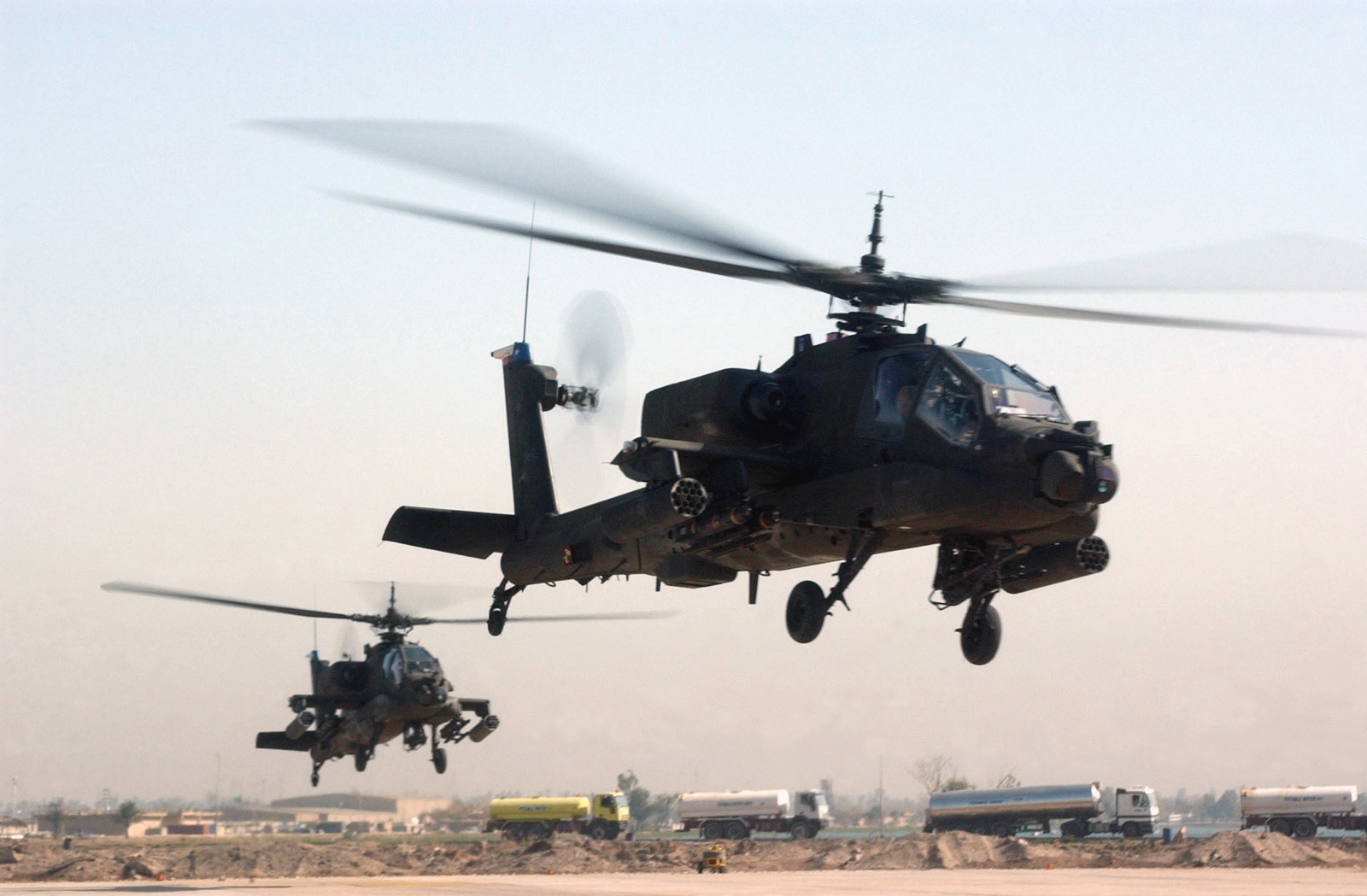To defeat the burgeoning drone menace in the Middle East, the AH-64 Apache helicopters deployed by the U.S. Army practiced shooting down drone targets as part of the ‘Red Sands Exercise’ with Saudi Arabia.
The U.S. Central Command (CENTCOM) recently published video footage from the Red Sands Exercise conducted last month, showing an AH-64D Longbow Apache attack helicopter destroying a target drone.
The Army also published photos of three U.S. Army AH-64 Apaches flying in a holding pattern at Red Sands IEC in the CENTCOM AOR on September 23, 2024. This was the third iteration of the exercise, which focused on the trial and use of counter-drone technologies and tactics in an evolving threat environment.
In the video footage, the AH-64 Apache helicopter can be seen attacking a hostile drone with the AGM-114 Hellfire missile—a rare maneuver that has not likely been disclosed in the past. CENTCOM did not specify the exact variant of the missile, but it is widely believed to be the AGM-114L Hellfire missile.
EurAsian Times, however, could not independently corroborate that information.
Nonetheless, the AGM-114L Hellfire is a short-range tactical missile typically used for destroying targets and conducting precision drone strikes.
The missile has an inertial navigation system, a fire-and-forget millimeter-wave (MMW) radar seeker, and homing capability in inclement weather. This makes the combination of an AH-64 Apache and AGM-114L a very destructive force.
. @USArmy Soldiers engage an unmanned aerial system (UAS) from an AH-64 with upgraded Hellfire missile during Red Sands training exercise in the Kingdom of Saudi Arabia. @usarmycentral pic.twitter.com/HG9ChuWxt6
— U.S. Central Command (@CENTCOM) September 30, 2024
The exercise in Saudi Arabia comes in the wake of the terror unleashed by drones. The Middle Eastern region has erupted with a proliferation of cheap and expendable drones fired by militias to attack high-value targets.
A striking illustration of this is the persistent drone attacks conducted by the Yemen-based Houthi militia on Western-origin container ships in the Red Sea. In fact, refineries in Saudi Arabia have also been attacked by long-range Houthi drones in the past, which makes the location of these drills significant.
While the Apache is best known as a combat-proven attack platform, the exercise demonstrates that the U.S. Army may be considering utilizing it in an air defense role in a region dominated by cheap and expendable drones. In a contingency, the U.S. Army could swiftly deploy the AH-64s to the frontline.

The U.S. Army is not the first military force to use helicopters to shoot down enemy drones.
In April 2024, a French helicopter, likely an NH-90, shot down a Houthi drone over the Red Sea in a rare air-to-air combat. No information was provided about the missile used to engage the drone. The NH-90 is known to be equipped with air-to-surface missiles and machine guns, much like the Apache.
According to reports, the Israeli military has also deployed the AH-64 Apache helicopter for engaging drones and in air defense roles for quite some time now. In August this year, a video of an Israeli Apache helicopter intercepting a Hezbollah Attack drone near northern Israel was published on social media.
Video of an Israeli Air Force Apache helicopter shooting down a UAV (drone) infiltrating Israeli territory from Lebanon. #IsraelHezbollahWar pic.twitter.com/aX2qpEYLwh
— Eretz Israel (@EretzIsrael) August 12, 2024
Additionally, the helicopter is also known to have shot down a Hezbollah drone near the Syrian border.
In another part of the world, embattled Ukrainian forces have started using helicopters to shoot down Russian one-way attack drones. However, unlike the AH-64 Apache helicopters firing Hellfire missiles, the Ukrainian choppers are shooting down Russian drones with machine guns installed in the noses of their Mi-8 Hip transport helicopters.
Apaches Against Drones
Experts have noted that deploying advanced helicopters like the Apache can have a distinctive advantage over ground-based air defense systems in a combat zone saturated with drones.
The AH-64 Apache can quickly take to the air to take on any incoming threats while positioned at the front, with support from ground forces if needed. Further, it would be significantly more agile than ground-based air defenses and swiftly reposition itself to engage an approaching target. The helicopter can also be deployed to escort other aircraft in a combat zone that are vulnerable to drones.

The radar-equipped Apache offers a networked, elevated weapons platform designed to detect low-flying, hard-to-spot targets within ground clutter, as explained by The War Zone in a recent report. The ability of the Apache’s radar to track and identify many targets simultaneously may also make it possible to engage enemy drone swarms quickly.
With drone warfare gaining prominence across the world, especially as part of asymmetric warfare in the Middle East, the United States is invested in designing counter-drone warfare strategies. This may also become a model to replicate for other operators of the advanced Apache helicopter, including the Saudi Air Force.
The use of the Apache would also be significant because using its avionics and onboard sensor suites, the AH-64 is built to withstand harsh frontline circumstances and to function in all weather conditions.
The most prominent sensors on the AH-64D Apache Longbow are the Radar Frequency Interferometer (RFI), which is placed in a dome above the main rotor, and the AN/APG-78 Longbow millimeter-wave fire-control radar (FCR) target acquisition system. The elevated radomes allow the helicopter to detect targets behind physical obstructions. More importantly, the AH-64D Longbow, a more recent and sophisticated variant of the helicopter, can track and process up to 256 targets simultaneously.
Since their inception, AH-64s have been equipped with a formidable air-to-air capability. The attack helicopter can launch Hellfire and FIM-92 Stinger short-range heat-seeking missiles. It can also carry 16 fire-and-forget Hellfire missiles. Further, it has a 30mm cannon that can also be used to fight drones.
Additionally, AH-64s now carry Joint-Air-to-Ground Missiles (JAGM) with their multi-mode seeker capabilities, which might significantly increase the helicopter’s effectiveness in countering drones.
Apaches can frequently operate underneath an enemy’s radar coverage while they are at combat altitudes of less than 100 feet. These helicopters can also detect low-flying targets, which might make them suitable for shooting down hostile drones on the frontline. The U.S., for now, appears to be exploiting the AH-64D’s counter-drone mission potential.
- Contact the author at sakshi.tiwari9555(at)gmail.com
- Follow EurAsian Times on Google News




